
Hanoi
How to travel to Hanoi for your best experience
Hanoi Travel Guide – What to do, when to visit, and more…
Hanoi, Vietnam's captivating capital, is home to seven million people and exudes an air of tradition and refinement. With its French colonial architecture, tree-lined boulevards, serene lakes, and the bustling Old Quarter, the city seamlessly blends the past with the present. Take a moment to witness locals practicing Tai Chi by the tranquil lakeside, while barbers and street food vendors ply their trade on lively sidewalks. Don’t regret missing the best places to go and the best things to do while you are here, by reading our complete travel guide or use Hanoi tours.
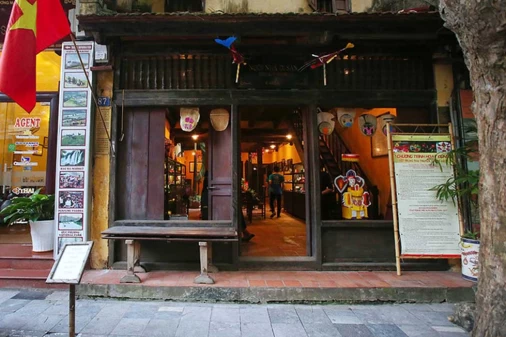
Ancient House Hanoi
According to the assessment of some historians, the ancient quarter in Hanoi made its appearance immediately...
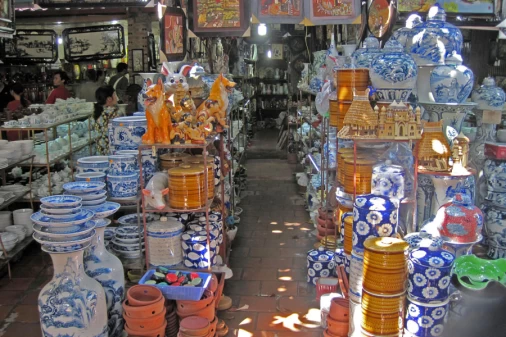
Bat Trang Ceramics Village
Bat Trang Ceramics Village is a 14th century porcelain and pottery village near Hanoi, housing local...
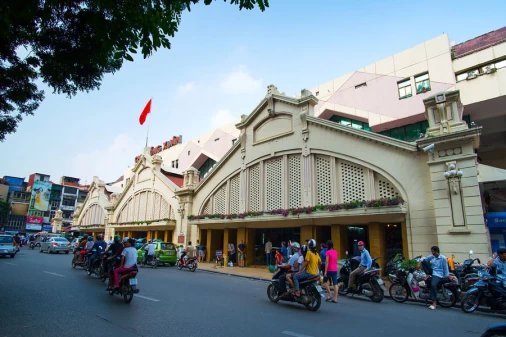
Dong Xuan Market
Hanoi tours, we may not forget the Dong Xuan market, an icon and interesting shopping destination of...
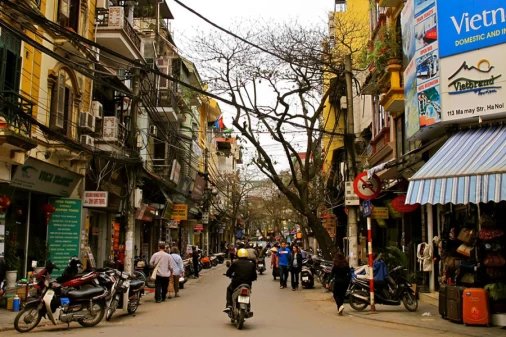
Hanoi Old Quarter
Hanoi tours, people also know “Hanoi with 36 streets” or “Hanoi old town”, with roads that have preserved...
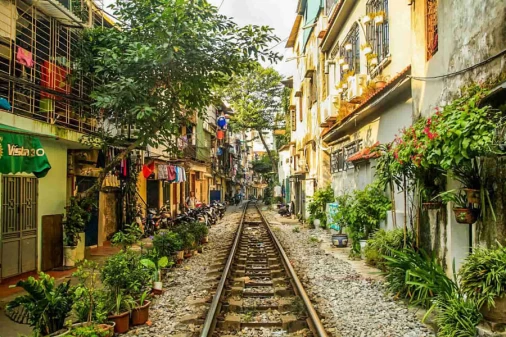
Hanoi Train Street
This is a narrow street in the Old Quarter, where train tracks run right down the middle, allowing trains...
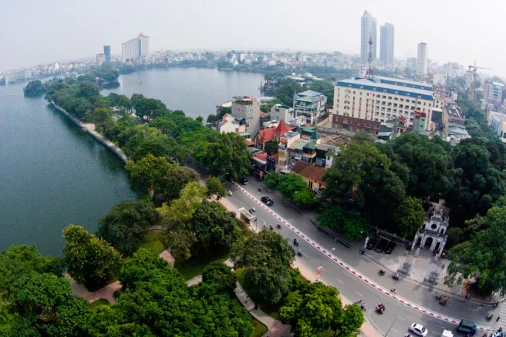
Hanoi West Lake
West Lake was created from a curved part of Red River and appeared in several Vietnamese legends. One...
Frequently asked questions
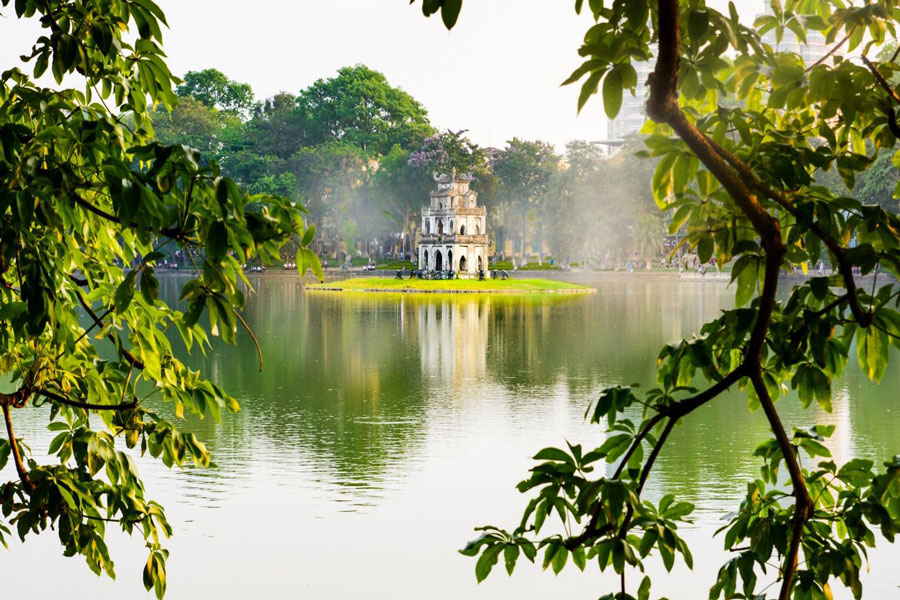
The wealth of Hanoi history is rich, epic and full of legends. Also, this French-colonial used-to-be city is a cultural mix of Eastern and Western influences which are mirrored in the style of many architectural gems, from remarkably preserved colonial buildings, unique museums to the world’s heritage mosaic and ancient pagodas. And they are just tourist attractions to visit alone, not to mention other interesting activities to join in the form of street art and casual culture. Let follow our guide of the best things to do to survive, and handily navigate through your stay (for your best experience in Hanoi).
I. To visit outstanding architectural landmarks
1. The Imperial Citadel of Thang Long
Opening Hours: Tuesday – Sunday, 08:00 – 17:00
Address: 9 Hoang Dieu Street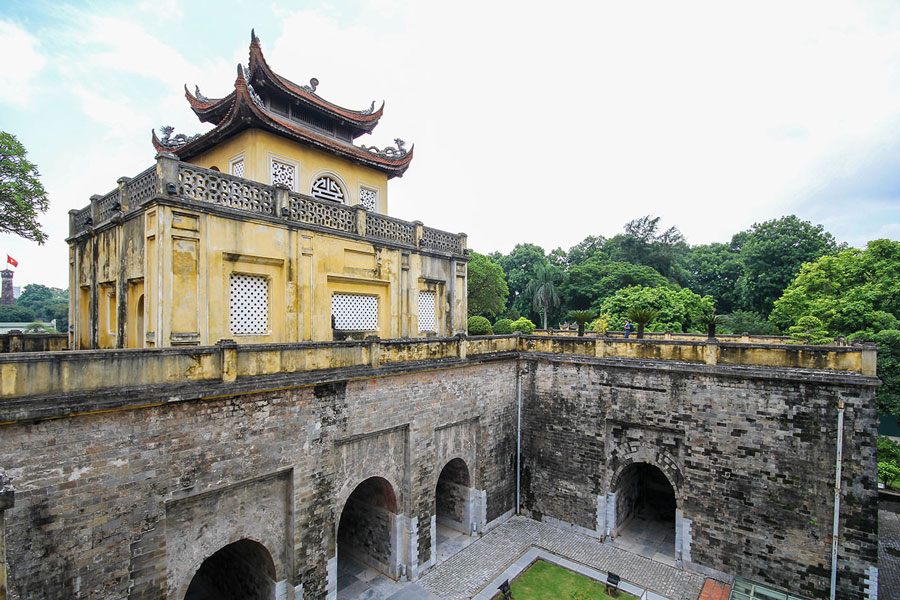
Thang Long Citadel is an attractive monument of Vietnamese history and has been recognized by UNESCO as a World Heritage Site in 2010. Also known as Hanoi Old Citadel, many antiques and items are from the middle. The 6th and 20th centuries were excavated in 2004, including the foundations of old castles, ancient roads, ponds, and wells. If you visit on holidays, you can also enjoy special art programs such as water puppet theater, exhibitions, folk games.
2. The Ho Chi Minh Mausoleum
Opening Hours: Tuesday – Thursday, 07:30 – 10:30, Saturday – Sunday 07:30 – 11:00
Address: 8 Hung Vuong Street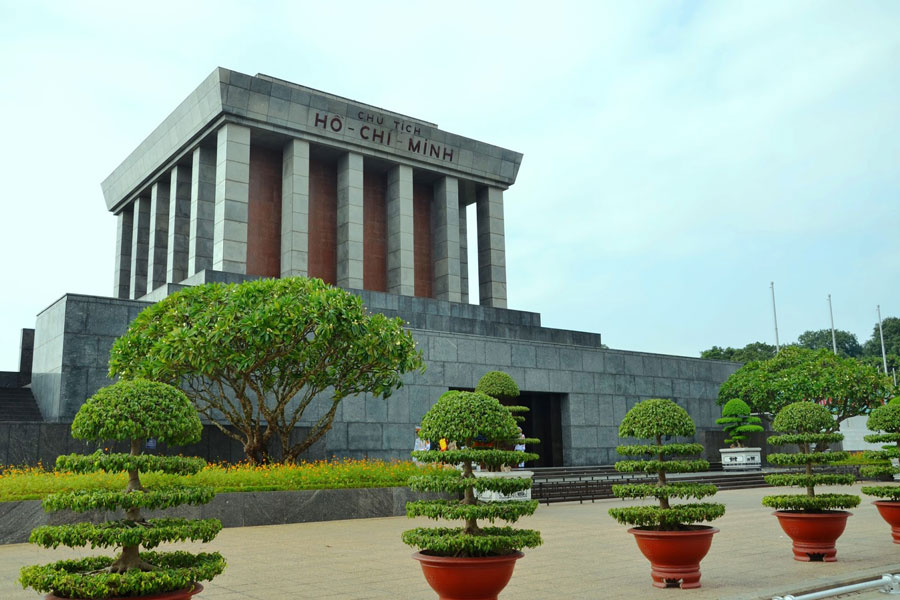
Ho Chi Minh Mausoleum at Ba Dinh Square is one of the most attractive attractions in Hanoi. It was Ho Chi Minh’s last resting place, Vietnam’s most famous leader, called “Uncle Ho” by his people. His body was preserved in a glass case at Ho Chi Minh Mausoleum in central Hanoi (though contrary to his wishes). For travelers, a trip to Uncle Ho’s final resting place can be an extraordinary experience because it is not just an average attraction. It is part of a unique history.
3. The Hoa Lo Prison
Opening Hours: Tuesday to Sunday, 7:30am-11:30am & 1:30pm-4:30pm
Address: #1, Hoa Lo Street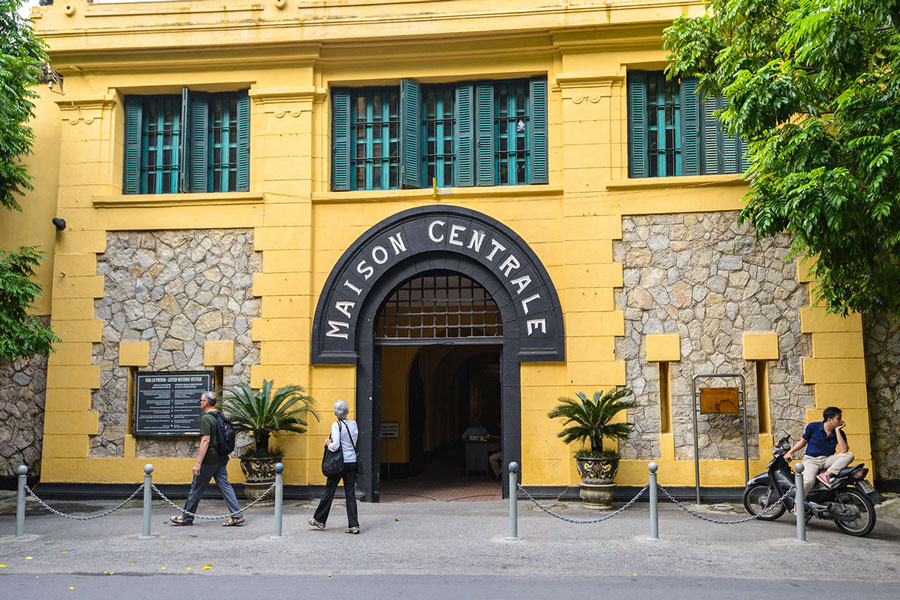
Originally named Maison Centrale, the prison was built by the French in 1896, on the site of what is now Hanoi’s downtown section. Among the items on display are various instruments of torture, including whips, shackles, and a guillotine. Also still preserved in their original condition are the French-period solitary confinement cells and the narrow tunnel through which more than a hundred Vietnamese prisoners escaped to freedom in August 1945.
4. The Temple of Literature
Opening Hours: Tuesday – Sunday, 8:30 – 11:30 & 13:30 – 16:30
Address: #58 Quoc Tu Giam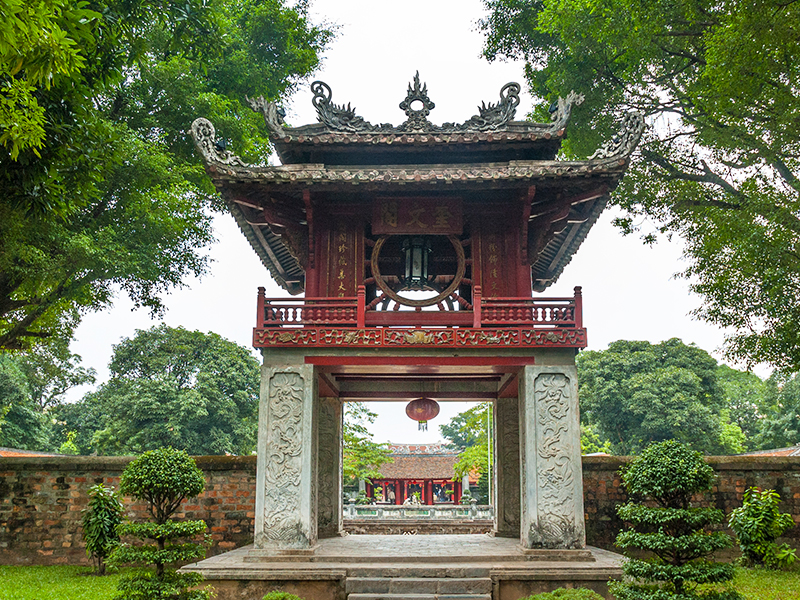
The Temple of Literature is often cited as one of Hanoi’s most picturesque tourist attractions. Originally built as a university in 1070 dedicated to Confucius, scholars, and sages, the building is extremely well preserved and is a superb example of traditional-style Vietnamese architecture. This ancient site offers a lake of literature, the Well of Heavenly Clarity, turtle steles, pavilions, courtyards and passageways that were once used by royalty. Visiting the Temple of Literature, you will discover historic buildings from the Ly and Tran dynasties in a revered place that has seen thousands of doctors graduate in what has now become a memorial to education and literature.
5. The One Pillar Pagoda
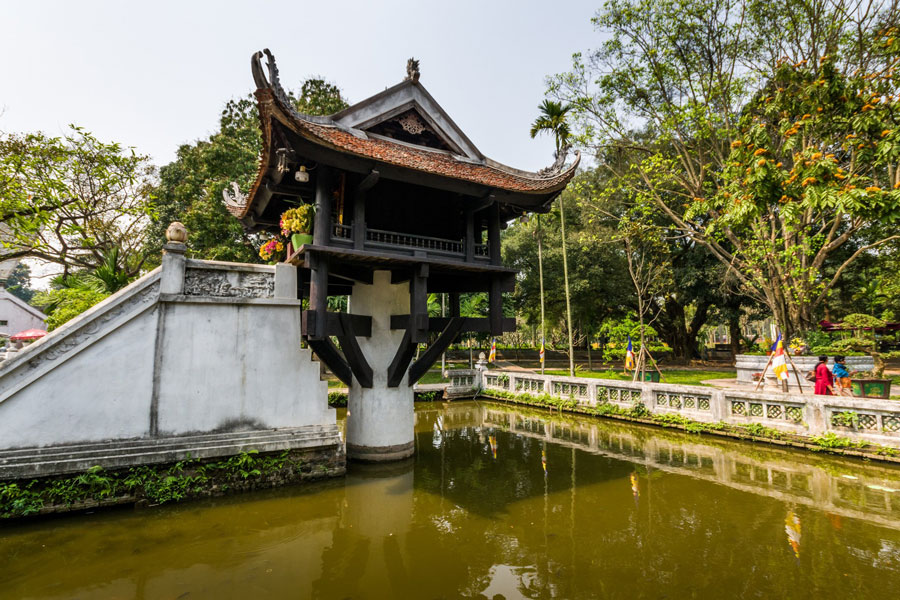
According to the tale an heirless Emperor had a dream in which he met a goddess of sorts name Avalokiteshvara which gifted him with a baby boy that was resting on a lotus flower. The Emperor Ly Thai wanted the pagoda to be built as the lotus blossom and that’s why it was built on a single pillar. The lotus blossom also symbolizes enlightenment in Buddhism.
Present day, the wooden pagoda is supported by a concrete pillar as replacement for the original one. The original wooden pillar was destroyed by the French. Another folk’s tale claims that the bo tree behind the pagoda is the same tree underneath Buddha became enlightened.
II. To attend academic performance
1. At the Hanoi Opera House
Address: #1 Trang Tien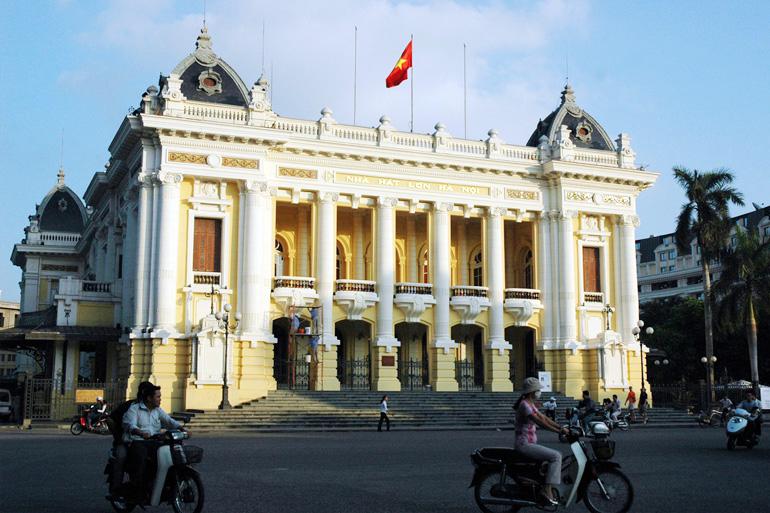
Built in 1911, the Hanoi Opera House is the biggest theatre in Vietnam and speaks volumes as historical and cultural evidence of Vietnam under French rule. It’s a phenomenal piece of neo-classical French architecture featuring Gothic themes on the doors and domes with pillars, shuttered windows, balconies and a glass room. The interior is even more magnificent than the exterior with many arguing it is aesthetically even more appealing than the Paris Opera House. Visitors today will be entertained at this architectural landmark which features a range of events including local Vietnamese opera, traditional folk music, ballet, and many international concerts.
2. At the Water Puppet Theatre
Opening Hours: Daily, 15:00, 16:10, 17:20, 18:30 & 20:00
Address: 57B, Dinh Tien Hoang Street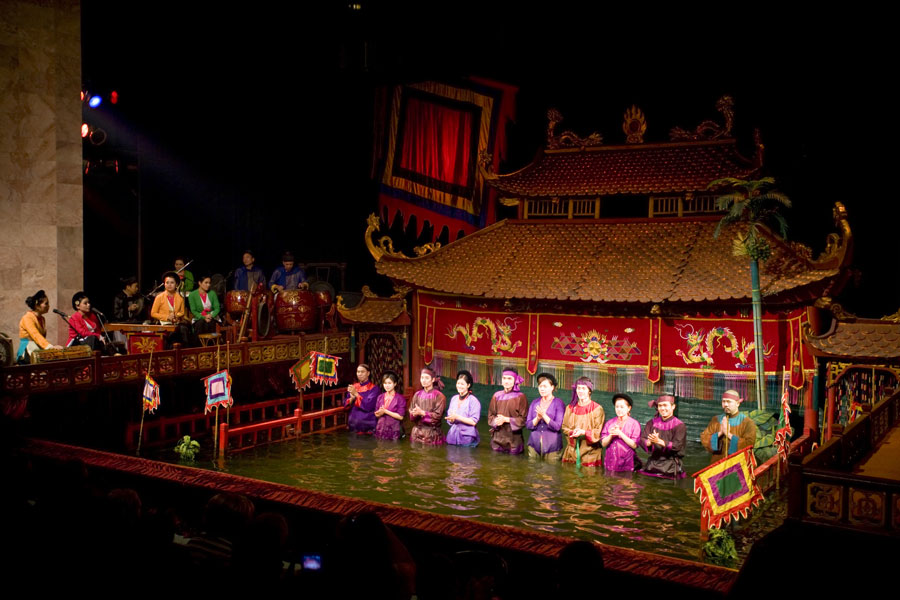
The world-famous Thang Long water puppet theater in Hanoi originates from an art form that dates back to the 11th century. Water puppet dancing has become a traditional art, a special creation of Vietnamese people. The tradition of the water puppet theater originates from the time when the rice fields are flooded and the villagers will entertain by standing underwater to the waist with puppets performing on the water. Using large sticks to support puppets, it appears as if they are moving on the water with puppets hidden behind the screen.
Currently, this type has been famous on stages around the world. The performance accompanied by a Vietnamese orchestra playing traditional music using drums, wooden bells, horns, bamboo flutes, and cymbals. There are also authentic Vietnamese songs that tell the story of the puppets taking place. Most programs recount Vietnamese folklore stories and legends with topics including a humorous rice harvest celebration described in a humorous way.
Most programs have the Legend of the famous King Le’s restored sword telling the story of Hoan Kiem Lake and the giant turtle. Live music is indispensable in the show and singers often shout encouraging words to puppets.
III. To experience casual lifestyle
1. Walking by Hoan Kiem Lake & visiting Ngoc Son Temple
Opening Hours: Daily, 08:00 – 17:00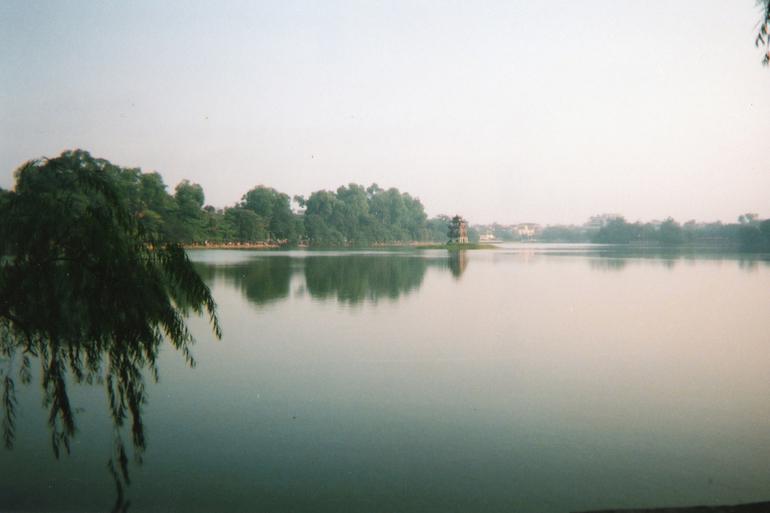
As one of the landmarks of Hanoi, Hoan Kiem Lake impresses tourists by tranquility and peacefulness, privately away from the bustling urban life. This is the only lake in Vietnam that is home to an iconic tortoise, that have a preserved specimen of a giant turtle weighing 250kg in Ngoc Son Temple, which sits in the center on a small island. The temple was built to commemorate of the 13th-century military leader Tran Hung Dao, famous for his bravery in the battle against the Nguyen dynasty. The lake and the temple are probably the most famous places in Hanoi to rest and admire great views.
Hoan Kiem lake is also very popular among Hanoians as a gathering place for families, nature lovers, sport practicers and hang outs. If you want to spend time like the local residents do, show up at 6 am and do exercise, practice Tai Chi or Yoga with them.
2. Shopping at Dong Xuan Market
Opening Hours: Daily 06:00 – 19:00
Address: Dong Xuan Street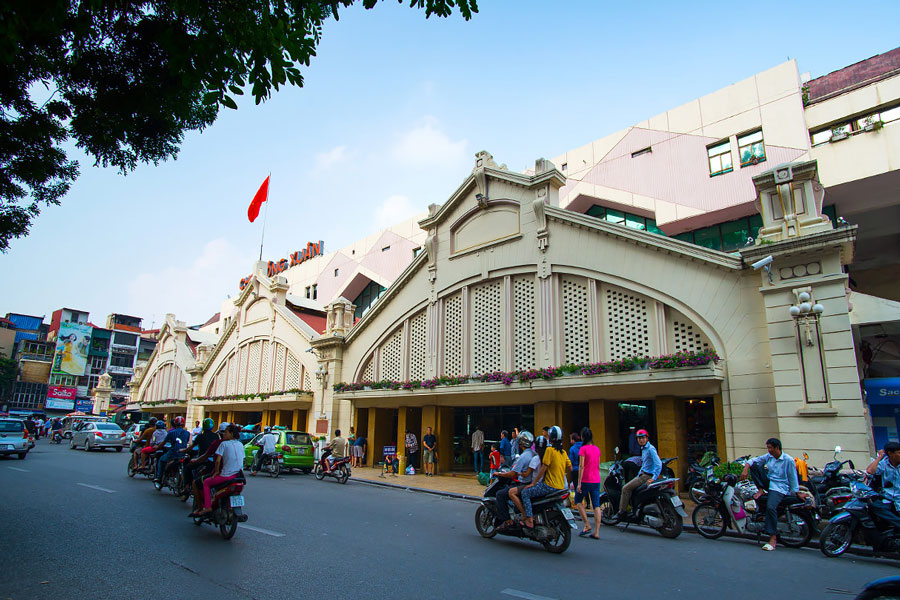
Established in 1889, Dong Xuan Market is housed within a four-story Soviet-style building on the northern edge of Hanoi Old Quarter. It’s also known as Hanoi’s largest indoor market, offering a wide range of goods such as fresh produce, souvenirs, accessories, and clothing, as well as electronic and household appliances.
Surrounding Dong Xuan Market are many more shops where you can purchase traditional Dong Ho drawings, Bat Trang ceramics, Binh Da embroideries and laces, and sand paintings. Within walking distance of Hoan Kiem Lake, Dong Xuan Market is a must-visit if you’re looking to experience the local lifestyle (you might even end up leaving with a pair of cheap sunglasses and a Vietnamese conical hat).
3. Wandering around Hanoi Old Quarter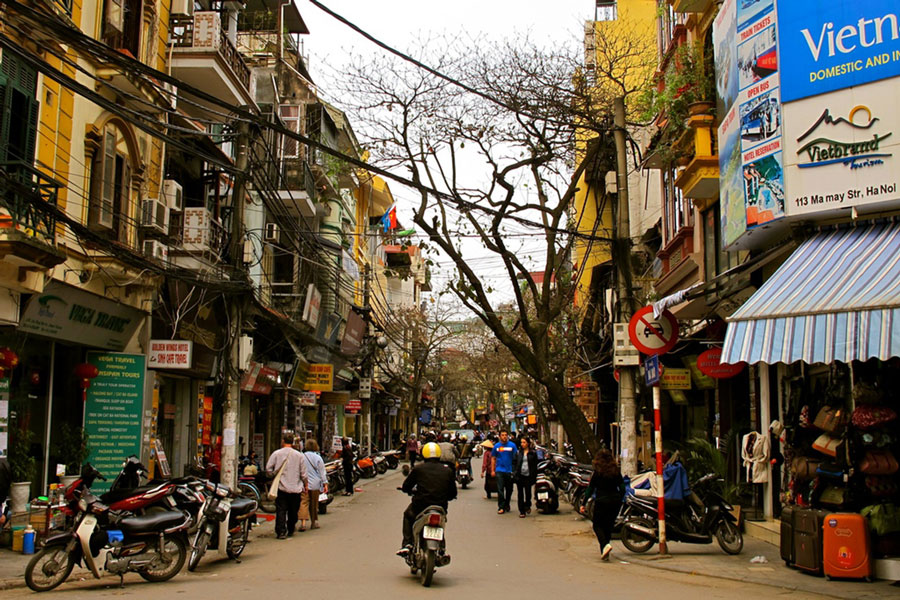
As being considered the city’s business hub and main tourist destination, Hanoi Old Quarter offers the French-colonial architecture, rich food culture, and a long history. One of the most common sights is that of streets packed with scooters, bicycles, and cars swarming around pedestrians like a school of fish. Then there are the many sidewalk vendors and people simply out for a stroll and the popular Old Quarter is no exception, so walking around this district is distinct from a leisurely stroll in the park. Visitors have no choice but to face the traffic in the local style but the experience of exploring the historical area is a must-do and truly well worth it.
4. Drinking at Bia Hoi (Draft beer) corner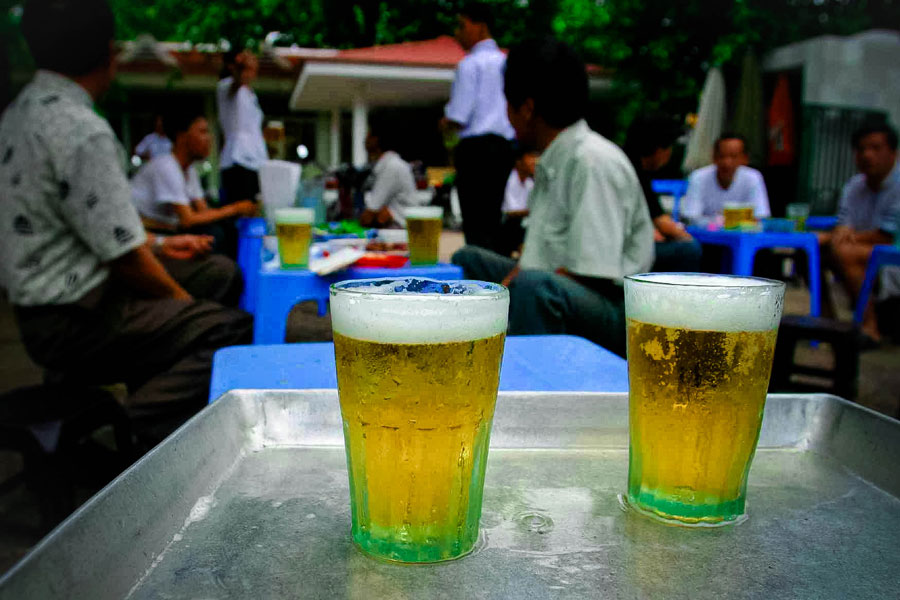
If you’re a beer enthusiast, you’ll be thrilled with Vietnam’s beer culture. Bia Hoi is known as a street beer and can be found almost everywhere. Some even say Bia Hoi is an insight into the beer scene of Vietnam. It’s a daily ritual starting from 4pm where locals (and tourists) sit on plastic furniture on street corners and drink home-brewed beer. Let join them.
5. Touring around the West Lake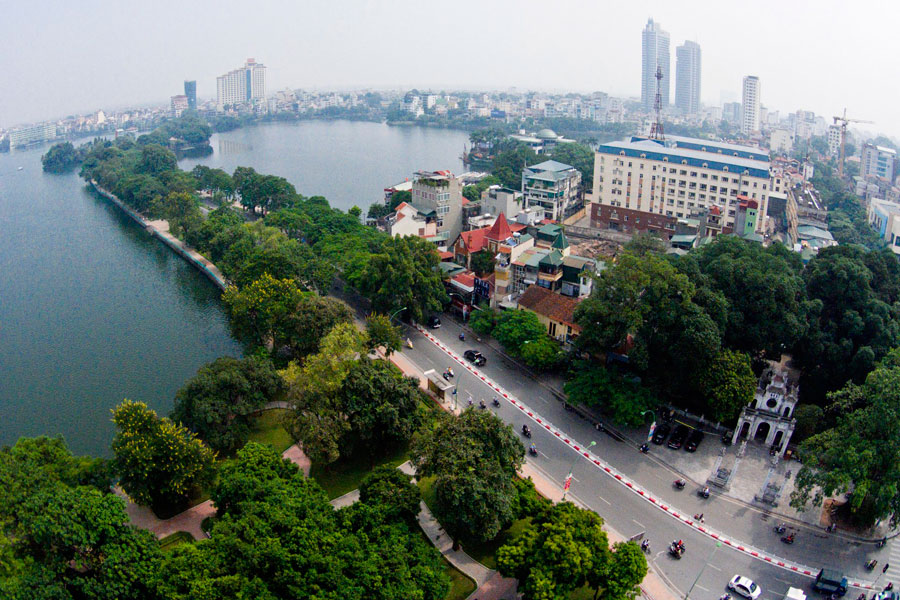
West Lake, or Ho Tay, Hanoi’s largest lake, is 15 km in circumference and is surrounded by upper-class suburbs as well as the Tay Ho expat district. It is also a very popular destination as it makes for a nice change from the hectic pace of Old Quarter.
The lake offers an opportunity to visit temples off the beaten path or to enjoy a cup of coffee or a refreshing beer whilst admiring the lake. You can navigate around the lake by bicycle and rest at one of the street side restaurants.
Let’s confront the fact, you will not have enough time to fully discover Hanoi from corner to corner. In fact, it could take you months to do so. But take it easy, we have narrowed down the choice to just the absolute must-see-and-do highlights within the agreeable 48 hours window, so you still can get a glimpse into this bustling city and get the most out of this 2-day itinerary.
Day 1: Hoan Kiem Lake & Ngoc Son Temple – Hanoi Opera House – The Old Quarter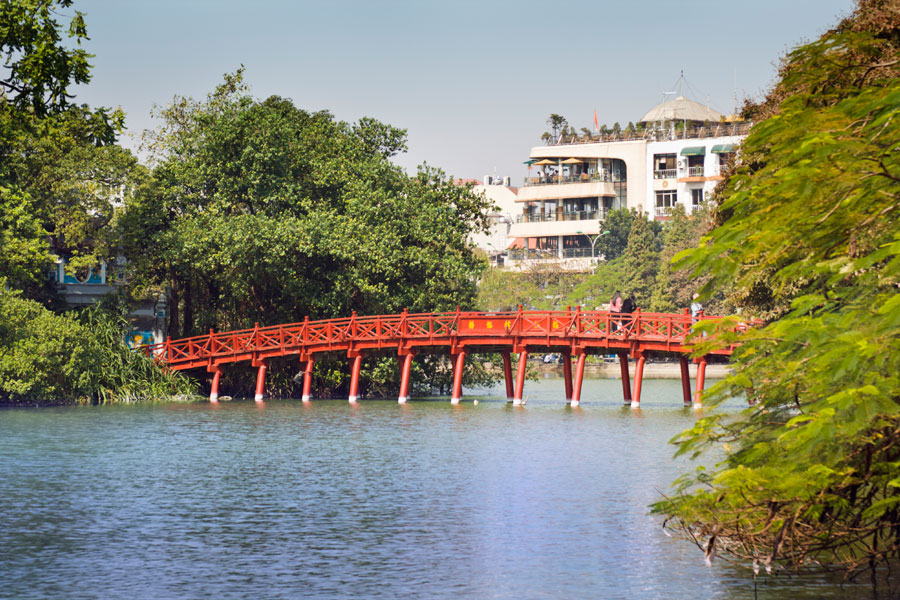
AM: Make your way to Hoan Kiem Lake, enjoy an early coffee and watch locals jogging, Tai Chi practising and line dancing. Visit Ngoc Son Temple and see a preserved specimen of a giant turtle. Then pass by Saint Joseph’s Cathedral.
PM: Get to Hanoi Opera House, recall colony architecture style. Then get to the Old Quarter to do some shopping, experience some foods and capture the Hanoi authentic atmosphere. Till late evening, mingle in weekend night market (if you are about at that time), gather at some Bia Hoi corner or join some vivid bar that welcome both locals and tourists.
Day 2: Ho Chi Minh Mausoleum – One Pillar Pagoda – Temple of Literature – Thang Long Imperial Citadel – WestLake – Maison Centrale – Water Puppet Theatre
AM: Visit Ho Chi Minh Mausoleum, see One Pillar Pagoda and the Temple of Literature to know how Hanoi’s iconic landmarks look like. Get to the Imperial Citadel of Thang Long to trace back the pass since 6th century of Hanoi.
PM: Get around the enormous West Lake to enjoy the fresh air. Pass by Maison Centrale to learn about Vietnam’s war history. Then go to watch the renowned traditional Thang Long Water Puppet performance in the evening,
If you are a veteran backpacker, please feel free to manage the trip your own and alter it when needed, else, we recommend you join a tour organized by a professional company, that can free you from hassles and keep you safe throughout the journey.
1. Cha Ca King – the Cha Ca restaurant chain, the fame of Hanoi
Address: 48 Nguyen Thi Dinh, Cau Giay District, Hanoi
If there was a book of UNESCO for foods, Cha Ca (grilled/ fried chopped fish) ought to be listed at the first pages.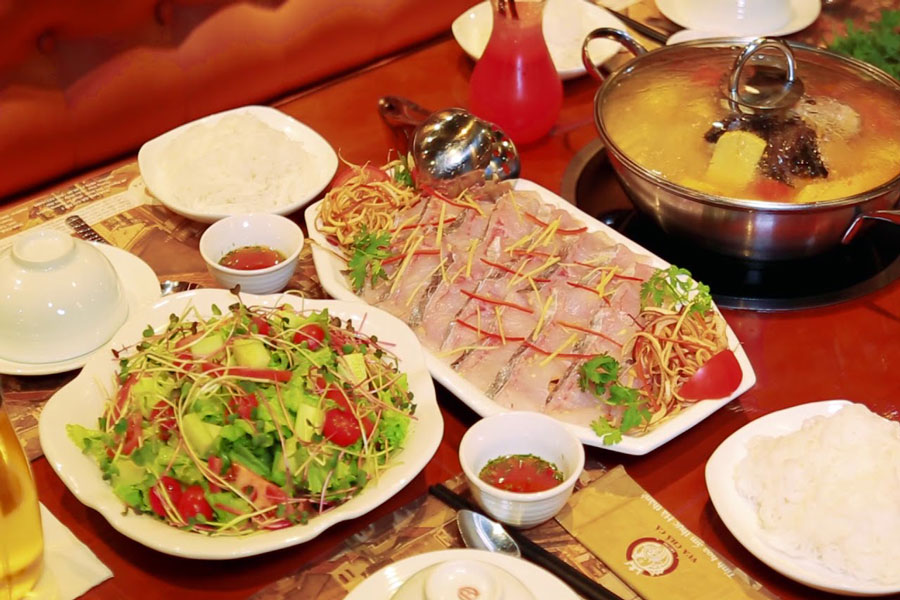
Favored by veteran gourmets, has been lasting for over decades, Cha Ca King leave its mark over Hanoians and tourists as the must-try (beside a couple of interesting things to do, while you still can – from prestigious Lonely Planet’s guide).
Being accompanied by Hanoi for years, that period proves that most gourmets send their love to Cha Ca King and it becomes the well-known brand in the Capital. With a modern hood system standardized by Korea, you will not be worried about the unpleasant smell of grease around you when enjoying Kinh Ky fish loaf – one of the best foods in Hanoi.
2. Bun Cha Huong Lien
Address: 24 Le Van Huu, Phan Chu Trinh, Hai Ba Trung, Hanoi
Already popular, this restaurant gained worldwide acclaim when President Obama and Anthony Bourdain ate Bun Cha together.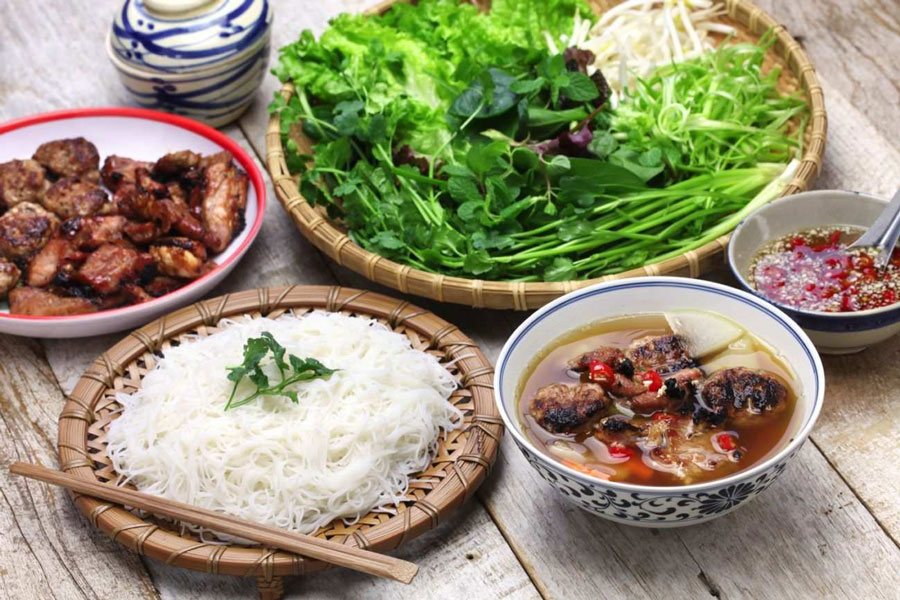
The pork balls are slightly fatty, incredibly juicy and tasty. Fresh herbs, noodles dipped into the special sauce, makes for an incredible harmony of flavors. A definite must eat in Hanoi dish!
Although the walls are now covered with Obama’s pictures, the cuisine remains the same – local, authentic and delicious. The look, however, may not be as luxurious as high graded restaurant, but this is still one of the best places to have Bun Cha in Hanoi.
3. Pho Thin
Address: 13 Lo Duc, Ngo Thi Nham, Hai Ba Trung, Hanoi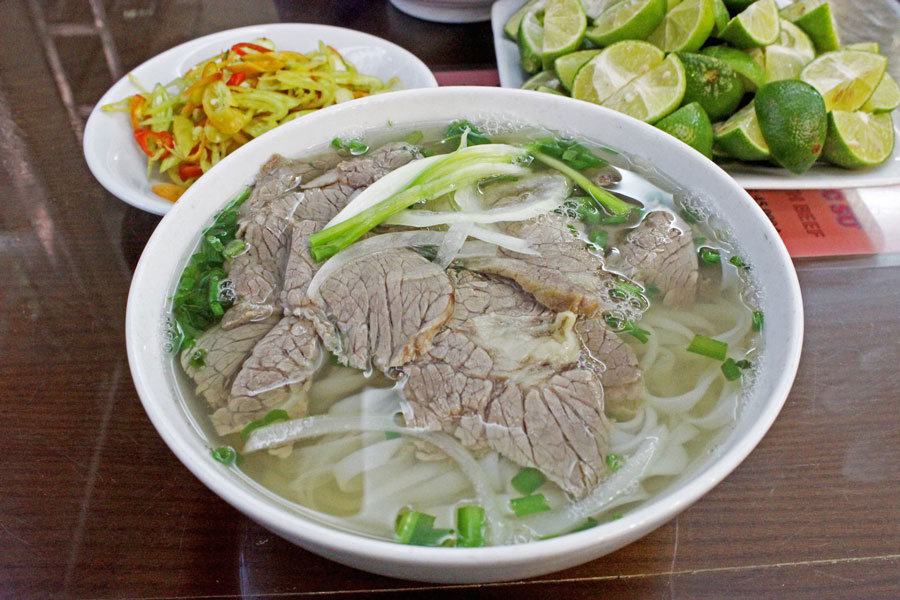
Pho is arguably Vietnam’s most iconic dish. It’s a Vietnamese noodle soup made with four ingredients – clear stock, rice, meat (beef or chicken), and a few herbs. From humble sidewalk stalls to upscale restaurants, you can find it everywhere in Hanoi, though many people believe that the city’s best Pho is served here at Pho Thin.
Opened in 1979, the restaurant’s owner Nguyen Trong Thin found a novel way to add flavor to classic Pho bo (Pho with beef). Instead of simply boiling the beef, he decided to stir-fry it with garlic before adding it to the soup. This minute innovation added new flavor components to the dish, turning a traditionally gentle stock into a more richly layered broth.
(For your reference, in the south, they use bean sprouts and a wider variety of fresh herbs. The broth in southern Pho is typically sweeter and with narrower noodles as well.)
4. Banh cuon Thanh Van
Address: 12 Hang Ga, Hang Bo, Hoan Kiem, Hanoi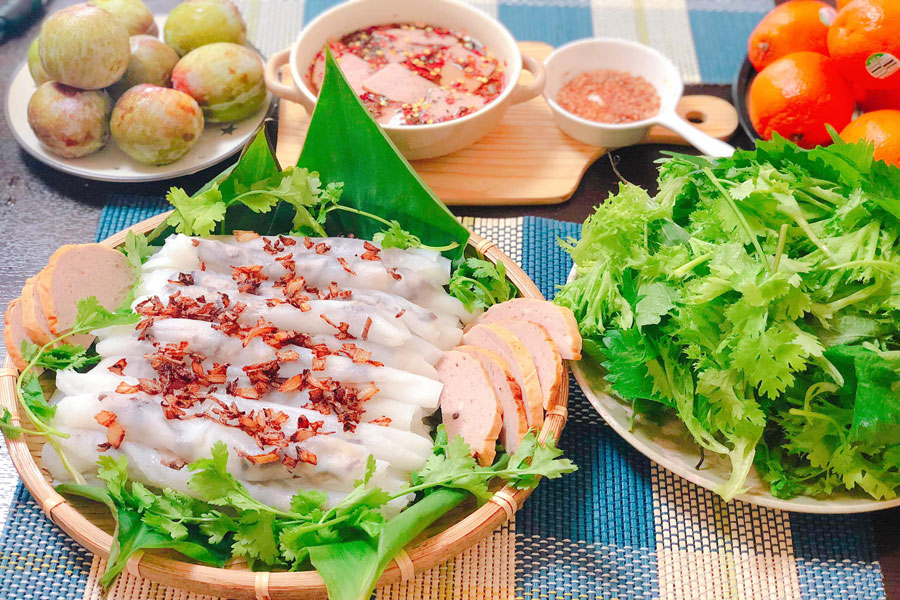
This restaurant is known for a dish called Banh Cuon. When we were there, it was obvious how popular this place is by all the tourists looking for it. There were even a couple of tour groups that stopped here for a bite to eat.
Banh cuon is made from a thin sheet of steamed fermented rice batter filled with seasoned ground pork and wood ear mushrooms. In fact, Banh cuon is typically made with pork but this restaurant offers other varieties as well, including rolls made with shrimp, as they’re topped with herbs and fried shallots and served with a bowl of fish sauce. The rice sheets were soft, slippery, and a little gummy. Both varieties of Banh cuon were delicious. They may remind you of those rice noodle rolls called Chee cheong fun served at Chinese dim sum restaurants.
5. Mien luon Dong Thinh
Address: 87 Hang Dieu, Hoan Kiem, Hanoi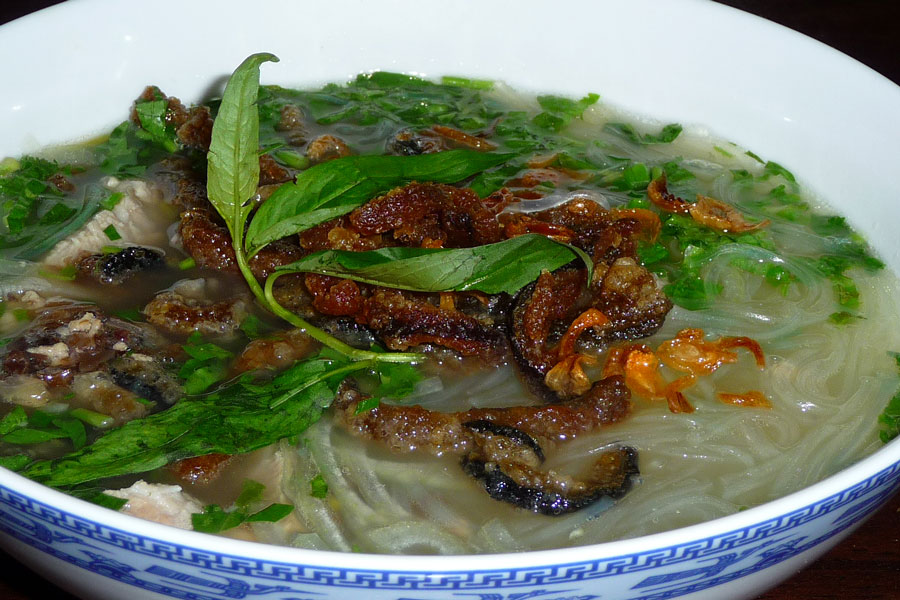
This restaurant is known for being one of the best places in Hanoi to have Luon (eel). Unlike Japanese unagi where the eel is grilled, most eel in Vietnam is dried then deep-fried so it’s crispy like dried anchovies. They were very crunchy but still had that signature sweetness. The eel was served with glass noodles (Mien), fried garlic and shallots, cucumber slices, chopped peanuts, and fresh herbs and greens with just a shallow layer of broth made from eel bones and ginger. Delicious!
6. Banh duc Thuy Khue
Address: 1 Alley 29, Thuy Khue, Tay Ho, Hanoi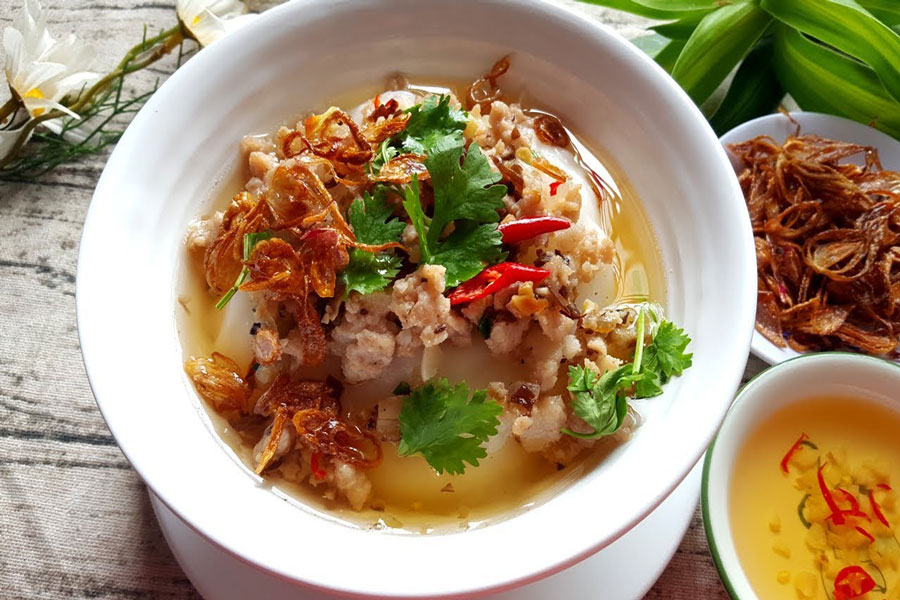
Banh duc is a series of steamed cake made of rice flour and molded into different shapes, usually a circle, rectangle, or triangle. You will eat this delicious type of rice cake with dipping sauces and it often has peanuts inside. Banh duc has two common varieties in Hanoi: savory banh duc and plain banh duc with peanut.
The savory banh duc is placed in a bowl and meat sauce is poured directly on top. The plain cake with peanut is cut into small pieces and it will be dipped into an accompanying sauce. Each dish brings different tastes; while the plain banh duc with peanut has a simple taste of rich rice flour, a bit brittle and slightly sweet of peanut, the savory one brings much more sophisticated flavors and appearance.
They say eating Banh duc is tasting the flavor of the authentic “rural” Vietnam.
7. Bun thang Ba Duc
Address: 48 Cau Go, Dong Da, Hanoi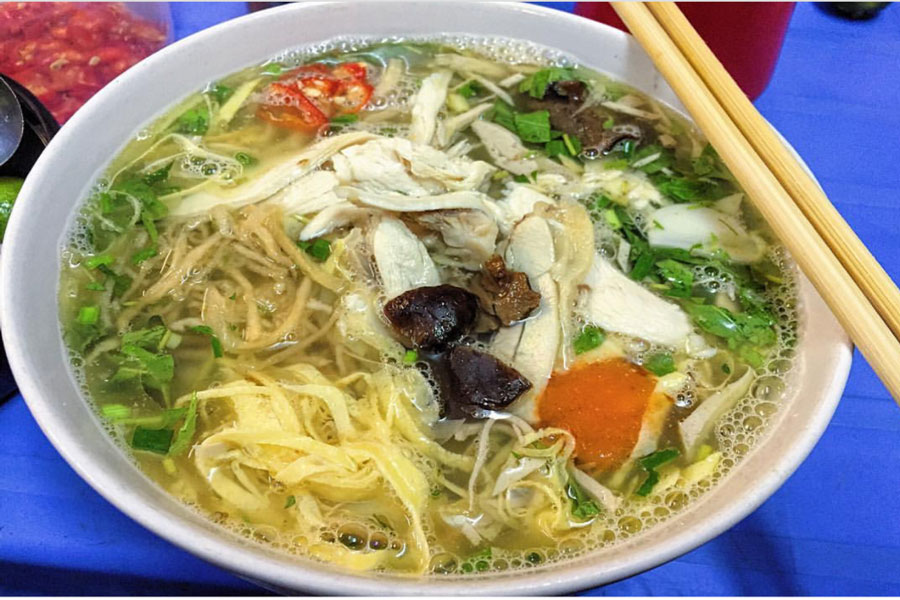
Bun thang is a special dish both in its name and in how it’s made. In the past, the Hanoian women cleverly used the remaining food from Tet (Vietnamese New Year) and combined the leftovers to make a new dish which was tasty and economical. The dish’s name is derived from this phrase: “Thang thuoc bo,” which means a package of rejuvenation.
Bun thang consists of many nutritious ingredients mixed together, just like the method used in Eastern medicine to mix herbs. This dish is made primarily of noodles and chicken soup; in addition, people can eat it with duck eggs, shrimp, squid, onions, garlic, or shiitake mushrooms. This combination makes bun thang not only delicious food but also a very nutritious one.
8. Xoi xeo Yen
Address: 35B Nguyen Huu Huan, Ly Thai To, Hoan Kiem, Hanoi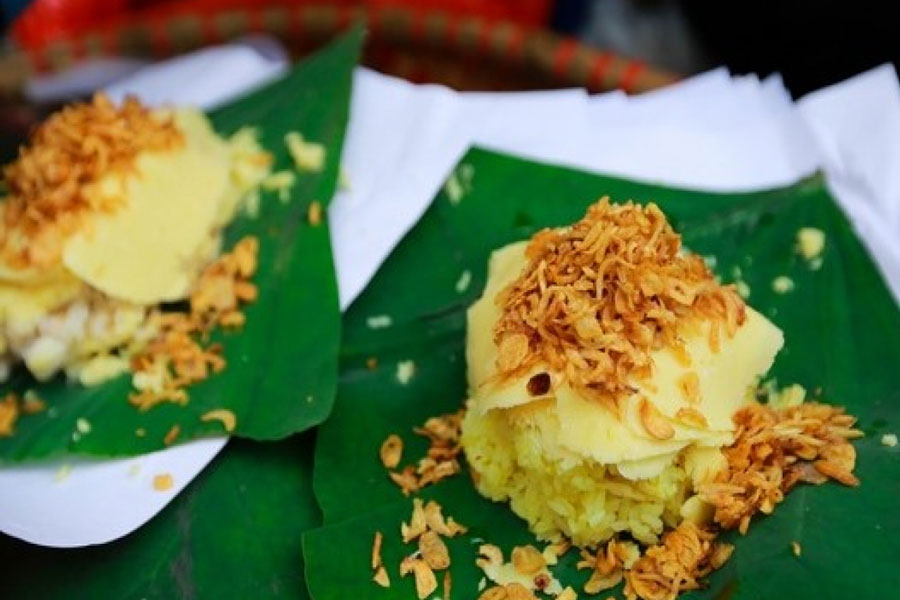
Xoi xeo is a typical fast food of Hanoians. It’s made of steamed glutinous rice and other delicious ingredients. During the steaming process, the rice is mixed with chicken fat. This steamed rice is then paired with mung bean, which is steamed and ground, and topped with crispy fried shallot. This fresh yellow xoi xeo is packaged in lotus leaf. The smells of chicken fat, crispy fried shallot, and lotus leaf combine to make a nondescript yet delectable scent of xoi xeo.
Though Xoi xeo is seem to be typical for breakfast, but you still can have it anytime of the day. It delivers the true taste of a street food that being along with Hanoians for generations.
Hanoi has four seasons, and as the city’s in the Northern hemisphere, that means the chilly winter starts in December and steaming summer hovers around early June. Also, the climate of Hanoi is quite typical for the Northern environment with the characteristics of a humid tropical monsoon climate, i.e. hot summer with a lot of rain whereas cold winter comes with lesser. More interestingly, the nuance of Hanoi alters each time seasons crossover, impressing tourists with eye-pleasing scenes and unmistakable feeling of what making of Hanoi, all year round. So, let’s find out how different Hanoi is, between seasons for your timing to visit.
How Hanoi is in Spring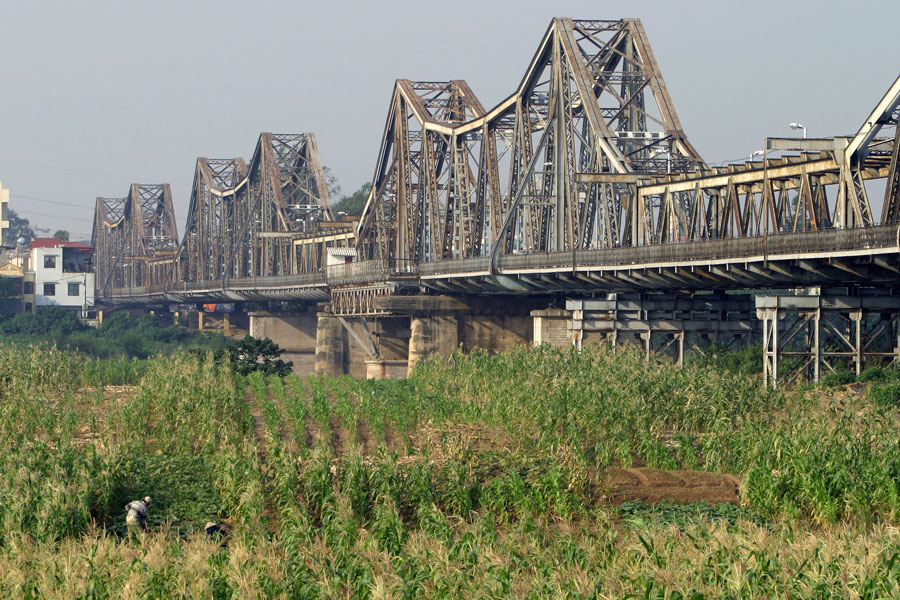
In common sense, the spring season, from February to April is considered Hanoi’s peak seasons, when travelers arrive at the most.
During this time, the city is not too hot and exploring the many beautiful tourist sites of the city can be undertaken with ease. The average temperature is about 25 degrees, and the cold air and warm sun make for the perfect weather — the landscape changes to hues and shades of yellow and golden that are splendidly scattered throughout the terrain. By the end of February, the chill is beginning to give way to a mild, pleasant dry climate.
It is also the perfect time for the fields and plants to blossom, giving way to beautiful rural and natural landscapes. This condition is ideally for exploring Hanoi by foot and witnessing a casual life on the street, besides whetting the appetite on some of the most sumptuous foods of Hanoi, such as Pho, Bun Cha and Xoi.
Takeaway for tourists: The Tet Festival, which is one of the most important and longest festivals of Vietnam also takes place during the spring season. Locals and tourists alike, wait for this special occasion to cheer themselves up. But be noted, the Tet holidays could also mean that most of the accommodations and modes of travel are booked choker block and some attractions, such as a few museums and shops may remain closed. However, Tet is the best time to witness the cultural intricacies of the nation that is in the mood of celebrations.
Besides, the Co Loa Festival in February takes place in the Co Loa Citadel and is known for wrestling and crossbow shootings, whereas, the Dong Festival in March in the Gia Lam district in Hanoi has special martial arts performances by famous masters. Another popular festival, the Le Mat Festival is usually celebrated in March and takes place in the Le Mat Village in the Hanoi district. The Keo Pagoda Festival is held in the spring and autumn and celebrated with palanquin procession, swimming race and traditional dances.
How Hanoi is in Summer

The summer and monsoon season, which lasts from May until August, of Hanoi are hot, humid and wet. There are thunderstorms and slight drizzles which continue for long hours. This makes it even more difficult to venture out and explore the city landscapes.
May, however, is still not too hot as compared to the other summer months. The temperature in May is around 28 degrees Celsius, and the skies are still relatively clear. However, with the onset of June, the summer begins in full force, with temperatures ranging from 29-33 degree Celsius. The highest temperatures in summer could also touch 40 degrees. June is usually the hottest month and also the month when the rainfall starts to descend.
July until August see the maximum rainfall that is usually as high as 200mm and more. The temperature in this period averages around 29 degrees.
The high temperatures coupled with rain are the main reasons why the summers are considered Hanoi’s offseason.
Takeaway for tourists: Looking at the bright side, low season also means that the tariffs are less and accommodations and bookings easier and more affordable.
Armed with a raincoat and umbrella, one can catch a few hours of outdoor sunshine, yet the unpredictable climate can make planning sightseeing tours go off in minutes. However, there are plenty of indoor activities to keep one busy in Hanoi too. Enroll in a cooking class or watch the rain drizzle from the window of a café while reading your favorite book. Besides, there are also a few festivals during the monsoon and summer months that can excite travelers to take the sweaty plunge.
The Chem Temple Festival in June which involves a water procession which consists of Dragon boats, the bullfighting festival of Do son Buffalo in August and the Dong Nhan Temple Festival are some of the monsoon festivals of the city.
How Hanoi is in Fall
Aside Spring, Fall (from September and November) is the most visited months of Hanoi that have glorious weather and clear skies. The temperatures range from 24-27 degrees with rainfall less than 100mm. Although leaves wither at some parts, there are different varieties of flowers that bloom in Fall. It is also the best time to venture out and explore the surrounding destinations of Hanoi.
You may want to visit the various city attractions, such as the Vietnam Museum of Ethnology, Ho Chi Minh Mausoleum, the West Lake, Hoa Lo Prison Memorial, Temple of Jade Mountain or Dong Xuan Market. Shop at its many local shopping centers or dine at the popular restaurants. Better stroll along the hawker crowded streets of Old Quarter to discover the city’s past. Or enjoy the delicious platter of street food, hopping from one stall to another.
Takeaway for tourists: The mild weather is the perfect way to explore the outdoors, shop and gobble the street food without caring much about the heat, sweat, rain or chill. There are also many events and festivals to look forward to in Fall.
The Liberation Day is celebrated on 10th October, the day when in 1954 Hanoi was liberated. The autumn celebration of the Keo Pagoda Festival is celebrated usually in October at the pagoda in the Thai Binh province with boat races, drum and trumpet competitions.
However, the most popular festival of this season is the fun-filled Mid-Autumn Festival celebrated in September. The lakes of Hanoi are especially beautified and thronged by locals and tourists, as lanterns soar to the sky and puppet shows, lion dances and exciting food stalls get crowded on the ground.
How Hanoi is in Winter
It does get freezing during winter in Hanoi. Warm clothes, jackets are an essential part of the wardrobe if one wants to move out. The temperatures average at 17 degrees but can drop to less than 10 degrees too. The low temperatures are further complemented by winds and high humidity making it feel much colder than the actual temperatures. Also, many buildings lack heating and insulation too.
There is hardly any rainfall with the average precipitation less than 50mm. The skies are usually cloudy and the weather foggy. The holiday season coupled with events and festivals is a reason enough to vacation in Hanoi during winters.
It is also the time to enjoy the warm street foods while chilling in the cold. A cup of hot egg coffee with noodles is just the right thing for a chilly evening. Pay a visit to Hanoi Cathedral on Christmas Eve or shop at the Christmas market in Old Quarters.
Takeaway for tourists: You can look forward to the Annual Flower Festival that takes place in the last week of December. The Tet Festival may fall at the end of January, depending on the dates of the lunar calendar. Thus, it is best to check the dates of the festival beforehand.
In conclusion of what is the best time to visit Hanoi:
Hanoi is always a great choice for foreigners on vacation because it is built by many beautiful landscapes and accompanied festive activities throughout the year. Answering the question of what is the best time to visit Hanoi maybe very personal, depending on your own taste and expectation.
Thus, there really is no bad time to visit Hanoi. Just be warned that the cold months can be a bit depressing, and if you hate the heat, don’t come in June through to August. Other than that, pack and plan appropriately and don’t let the weather spoil your visit. Friendly local people are always available to welcome you to have an awesome experience during your trip.
Throughout this article, we wish you to have an idea of how to travel to Hanoi for your best experience. In case you are looking for your own travel agent, who can offer a wonderful and hassle-free trip to Hanoi, please feel free to let us know. We always commit our best to make it your once-in-a-lifetime journey.
You may also like
7-Day Authentic Northern Vietnam
- Depart Time:Daily
- Starts/Ends:Hanoi/Hanoi
- Tour type:Private Tours
- Travel Style:Nature & Adventure, Family Tours
- Activities:Adventure tours, Cruise tours, Countryside and village visits tours
- Suitable for:Solo, Family, Group, Couple
- Age range:1 To 90 Years
- Operated in:English, French, Spanish, German, Italian
Discovery North Western 7 Days
- Depart Time:Daily
- Starts/Ends:Hanoi/Hanoi
- Tour type:Private Tours
- Travel Style:Nature & Adventure, Family Tours
- Activities:Walking tours, Local culture tours, Countryside and village visits tours
- Suitable for:Solo, Family, Group, Couple
- Age range:1 To 90 Years
- Operated in:English, French, Spanish, German, Italian
Best of Nature in Northern Vietnam 6 Days
- Depart Time:Daily
- Starts/Ends:Hanoi/Hanoi
- Tour type:Private Tours
- Travel Style:Nature & Adventure, Heritage Tours, Family Tours
- Activities:Trekking and Hiking, Cruise tours, Sightseeing Tours, Countryside and village visits tours
- Suitable for:Solo, Family, Group, Couple
- Age range:1 To 90 Years
- Operated in:English, French, Spanish, German, Italian
Best of Nature in Northern Vietnam 8 Days
- Depart Time:Daily
- Starts/Ends:Hanoi/Hanoi
- Tour type:Private Tours
- Travel Style:Nature & Adventure, Family Tours, Culture & History
- Activities:Trekking and Hiking, Sightseeing Tours, Countryside and village visits tours
- Suitable for:Solo, Family, Group, Couple
- Age range:1 To 90 Years
- Operated in:English, French, Spanish, German, Italian
Best of Nature in Northern Vietnam 7 Days
- Depart Time:Daily
- Starts/Ends:Hanoi/Hanoi
- Tour type:Private Tours
- Travel Style:Nature & Adventure, Heritage Tours
- Activities:Trekking and Hiking, Sightseeing Tours, Countryside and village visits tours
- Suitable for:Family, Group, Couple
- Age range:1 To 90 Years
- Operated in:English, French, Spanish, German, Italian
Best Of Northern Vietnam 9 Days
- Depart Time:Daily
- Starts/Ends:Hanoi/Hanoi
- Tour type:Private Tours
- Travel Style:Nature & Adventure, Culture & History
- Activities:Trekking and Hiking, Sightseeing Tours, Countryside and village visits tours
- Suitable for:Solo, Family, Group, Couple
- Age range:1 To 90 Years
- Operated in:English, French, Spanish, German, Italian
 France
France  Spain
Spain  German
German  Italian
Italian 




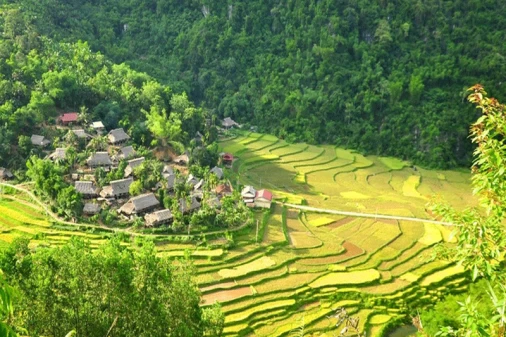


 Vietnam Tours
Vietnam Tours  Cambodia Tours
Cambodia Tours  Myanmar tours
Myanmar tours  Thailand Tours
Thailand Tours  Laos Tours
Laos Tours